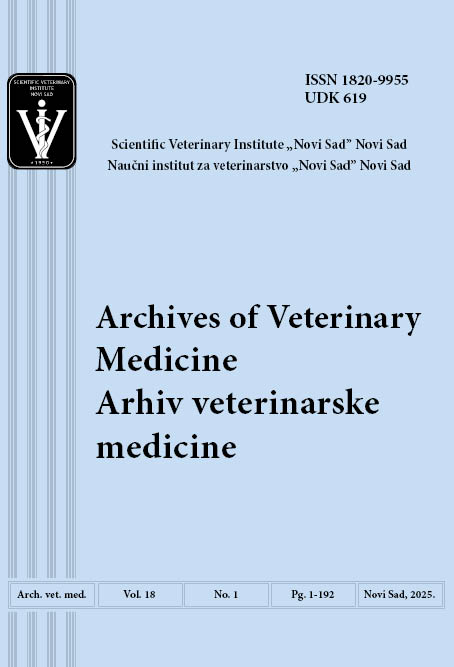Abstract
The Balkan donkey (Equus asinus asinus), an endangered breed native to Serbia with significant historical importance, has not been extensively studied in terms of its health and physiology. As their numbers continue to decrease, studying their physiological traits is key to designing effective conservation strategies. This study evaluated the hematological and biochemical profiles of 70 clinically healthy Balkan donkeys, divided into three age groups: Group A (5-7 months), Group B (12-14 months), and Group C (4-7 years). The analysis revealed notable age-related differences (p < 0.05) in several key parameters. Younger donkeys (Groups A and B) showed heightened immune activity, as indicated by elevated white blood cell (WBC) counts, indicative of their developing immune systems. In contrast, adult donkeys (Group C) demonstrated stable immune profiles and elevated urea levels, likely linked to protein metabolism or hydration status. Consistent red blood cell (RBC) and platelet counts across all groups suggested efficient oxygen transport and coagulation. Higher phosphorus levels in younger donkeys suggested metabolic needs related to growth. Meanwhile, stable liver (ALT) and kidney (creatinine) function across all age groups underscored the breed’s resilience to environmental and physiological challenges.
This study provides the first comprehensive dataset on the hematological and biochemical health of the Balkan donkey, providing valuable insights for veterinary diagnostics, conservation efforts, and breed management. By establishing baseline health data, this research not only aids in preserving this endangered breed but also enhances our understanding of donkey physiology in demanding ecological conditions.
References
Beja-Pereira A., England P.R., Ferrand N., Jordan S., Bakhiet A.O., Abdalla M.A., Mashkour M., Jordana J., Taberlet P., Luikart G. 2004. African origins of the domestic donkey. Science, 304(5678): 1781. https://doi.org/10.1126/science.1096008
Burden, F.A., Hazell-Smith, E., Mulugeta, G., Patrick, V., Trawford, R., Brooks Brownlie, H.W. 2016. Reference intervals for biochemical and haematological parameters in mature domestic donkeys (Equus asinus) in the UK. Equine Veterinary Education, 28: 134-139. https://doi.org/10.1111/eve.12512
Caldin, M., Furlanello, T., Solano-Gallego, L., Lorenzi, D. D., Carli, E., Tasca, S., & Lubas, G. 2005. Reference ranges for haematology, biochemical profile and electrophoresis in a single herd of Ragusana donkeys from Sicily (Italy). Comparative Clinical Pathology, 14(1): 5–12. https://doi.org/10.1007/s00580-005-0544-8
Food and Agriculture Organization (FAO). 2011. The state of the world’s animal genetic resources for food and agriculture. Rome, Italy: FAO.
Goodrich E.L., Webb J.L. 2024. Complete blood count and biochemistry reference intervals for healthy adult donkeys in the United States. Animals, 14(14): 2018. https://doi.org/10.3390/ani14142018
Ivanković A., Caput P., Mioč B., Pavić V. 2000. The phenotype features of donkeys in Croatia. Agriculturae Conspectus Scientificus, 65(2): 99–105.
Ivanković A., Kavar T., Caput P., Mioč B., Pavić V., Dovc P. 2002. Genetic diversity of three donkey populations in the Croatian coastal region. Animal Genetics, 33(3): 169–177. 10.1046/j.1365-2052.2002.00879.x
Kugler W., Grunenfelder H.P., Broxham E. 2008. Donkey Breeds in Europe: Inventory, Description, Need for Action, Conservation; Report 2007/2008. St. Gallen, Switzerland: Monitoring Institute for Rare Breeds and Seeds in Europe.
Laus F., Spaterna A., Faillace V., Paggi E., Serri E., Vullo C., Cerquetella M., Tesei B. 2015. Reference values for hematological and biochemical parameters of mixed breed donkeys (Equus asinus). Wulfenia Journal, 22(1): 295–304.
Martini M., Altomonte I., Tricò D., Lapenta R., Salari F. 2021. Current Knowledge on Functionality and Potential Therapeutic Uses of Donkey Milk. Animals. 11(5):1382. https://doi.org/10.3390/ani11051382
Norris S.L., Little H.A., Ryding J., Raw Z. 2021. Global donkey and mule populations: Figures and trends. PLOS ONE, 16(2): e0247830. https://doi.org/10.1371/journal.pone.0247830
Sedlinská M., Biricová D., Horáčková E., Mráčková M. 2016. Selected haematological and biochemical indices in donkeys in the Czech and Slovak Republics. Acta Veterinaria Brno, 85(3): 227–230. https://doi.org/10.2754/avb201685030227
Silva G., Silvestre-Ferreira A.C., Leiva B., Queiroga F.L. 2024. Serum biochemistry parameters of the endangered Miranda’s donkey breed: Reference intervals and the influence of gender and age. Animals, 14(5): 805. https://doi.org/10.3390/ani14050805
Stanišić, L., Dimitrijević, V., Simeunović, P., Lakić, N., Radović, I., Ivanković, A., Stevanović, J., Stanimirović, Z. 2015. Morphological, biochemical and hematological characterization of endangered balkan donkey breed. Acta Veterinaria-Beograd, 65(1): 125-136. https://doi.org/10.1515/acve-2015-0010
Trimboli F., De Amicis I., Di Loria A., Ceniti C., Carluccio A. 2020. Reference Ranges for Hematological and Biochemical Profile of Martina Franca Donkeys. Frontiers in Veterinary Science, 18,7: 602984. https://doi.org/10.3389/fvets.2020.602984.
Vučićević M., Drljačić A., Francuski J., Ivanov S., Trailović R., Trailović D. 2011. Estimation of physiological values of haematological parameters in domestic Balkan donkey before and after the grazing period. In Proceedings of the 2nd International Fair of Horse Breeding, Novi Sad, Serbia 194–200.

This work is licensed under a Creative Commons Attribution 4.0 International License.
Copyright (c) 2025 Archives of Veterinary Medicine
